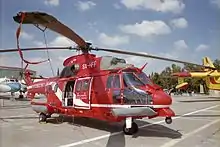Hellenic Fire Service
The Hellenic Fire Service (Greek: Πυροσβεστικό Σώμα, romanized: Pyrosvestiko Soma) is the national agency of Greece for fire and rescue service. It is part of the Ministry for Citizen Protection.[1]
| Πυροσβεστικό Σώμα Pyrosvestiko Soma | |
| Fire Service overview | |
|---|---|
| Formed | 1926 |
| Preceding Fire Service |
|
| Jurisdiction | Greece |
| Headquarters | Athens, Greece |
| Motto | ΘΑΡΣΕΙΝ ΣΩΖΕΙΝ (Bravery Saves [Lives]) |
| Employees | ~21,000
(11.470 full-time firefighters 2.410 5-year contract firefighters 3,438 seasonal firefighters 3,573 volunteer firefighters) |
| Fire Service executives |
|
| Website | www |
History
_(30595740062).jpg.webp)
In 1833, with the establishment of the Greek Kingdom, the fire responsibility was given to the individual prefectures and municipalities. In 1854 a Firemen Company (Λόχος Πυροσβεστών) was formed in Athens, as part of the Greek Army, expanded in 1861 into a two-company mixed sapper and firemen formation (Διλοχία Σκαπανέων και Πυροσβεστών). It was not until 1914 that the corps, now again known as Firemen Company and still under military control, was expanded to other cities outside Athens, covering also Thessaloniki, Patras and Piraeus.
In 1926, the Fire Service was formed as a separate branch within the military, but proved ineffective, so that in 1929, a Greek émigré from Russia, the former head of St Petersburg Fire Service Alkiviadis Kokkinakis, was tasked with reforming the service. In 1930, the Fire Service was reconstituted as an independent national authority under the Ministry of the Interior. Until 1975 the chiefs of the service were transferred from the Gendarmerie or the Cities Police.
From 1998 the Fire Service has also the responsibility for forest fires, taking over from the Forestry Service.
Operation

Its mission is to provide safety for the citizens and their property. It operates during fires, forest fires, car accidents, other natural or man-made disasters and during rescue operations. Other duties include the collaboration with the other Greek security forces, prevention measures and information and/or education of the public. The various legal and regulatory texts describing the organization and operation of the Fire Service were codified in 1992 in Presidential Decree 210.[2]
Organization

- The central body is located in Athens
- Regional Fire Services Administration
- Fire station of four grades (a,b,c,d) throughout the country
- Smaller fire stations (klimakia), plus voluntary fire stations and voluntary klimakia
- Special Units for disasters (EMAK)
- Special services:
- Firefighting Academy
- Coordinating Center (tel.199)
- General Warehouse Material
- Confrontation of arson crimes
Voluntary Corps
In 1991, a new Voluntary Corps was formed for volunteers[3][4] (today the 15% of the strength). Volunteers act as a support force and they have to be officially recognized and trained by the Greek state. The legal and regulatory framework for volunteers in the Hellenic Fire Service and the Hellenic Coast Guard was updated with Law 4029 in 2011.[5]
Equipment
Since the 1930s, the Fire Service has used more than 3,500 vehicles. Today it owns about 2,500 trucks and cars (1,500 fire engines and fire tenders, 800 auxiliary and 200 special), 44 firefighting aircraft, 20 helicopters (5 belonging to the House and 15 leased) and 10 firefighting vessels.
Training
The training takes place at the Firefighting Academy (Pyrosvestiki Akademia) which is located in Kato Kifissia (38°04′55″N 23°47′18″E) with an annex at Villia Attikis. The first "Firefighting School" was established in 1936 at Sarri Street (an outpost of the 1st Fire Station) in Athens, while the Academy was established in 1968.
Ranks
| Title | Lieutenant general | Major general | Brigadier | Colonel | Lieutenant colonel | Fire major | Fire captain | Fire lieutenant | Fire second lieutenant | |
|---|---|---|---|---|---|---|---|---|---|---|
| Greek title | Αντιστράτηγος Antistrátigos |
Υποστράτηγος Ypostrátigos |
Αρχιπύραρχος Archipýrarchos |
Πύραρχος Pýrarchos |
Αντιπύραρχος Antipýrarchos |
Επιπυραγός Epipyragós |
Πυραγός Pyragós |
Υποπυραγός Ypopyragós |
Ανθυποπυραγός Anthypopyragós | |
| Insignia |  |
 |
 |
 |
 |
 |
 |
 |
 |
| Title | Warrant officer (NCO) | Master sergeant | Sergeant | Senior firefighter | Firefighter |
|---|---|---|---|---|---|
| Greek title | Πυρονόμος Pyronómos |
Αρχιπυροσβέστης Παραγωγικής Σχολής Archipyrosvéstis Paragogikís Scholís |
Αρχιπυροσβέστης Μη Παραγωγικής Σχολής Archipyrosvéstis Mi Paragogikís Scholís |
Υπαρχιπυροσβέστης Yparchipyrosvéstis |
Πυροσβέστης Pyrosvéstis |
| Insignia |  |
 |
 |
 |
 |
Gallery
 Old TEMAX fire-fighting vehicle
Old TEMAX fire-fighting vehicle Fire in ultra-high voltage transformer
Fire in ultra-high voltage transformer Fire station in Thessaloniki
Fire station in Thessaloniki HFS automobile
HFS automobile HFS Jeep
HFS Jeep HFS vehicle
HFS vehicle ELVO fire engine
ELVO fire engine TEMAX fire engine
TEMAX fire engine A Mil Mi-26TC in firefighter role in action
A Mil Mi-26TC in firefighter role in action
Notes and references
- Αποστολή - Αρμοδιότητες (
- Presidential Decree 210, Government Gazette A 99, 1992-06-16
- Ο Θεσμός του Εθελοντή Πυροσβέστη,Πυροσβεστικό Σώμα (www.fireservice.gr)
- "Nomothesía - Diatagés, P.E.E.P.S." Νομοθεσία - Διαταγές, Π.Ε.Ε.Π.Σ. [Legislation - Orders, P.E.E.P.S.] (in Greek). Archived from the original on 2012-01-28. Retrieved 2014-03-26.
- Law 4029, Government Gazette A 245, 2011-11-22